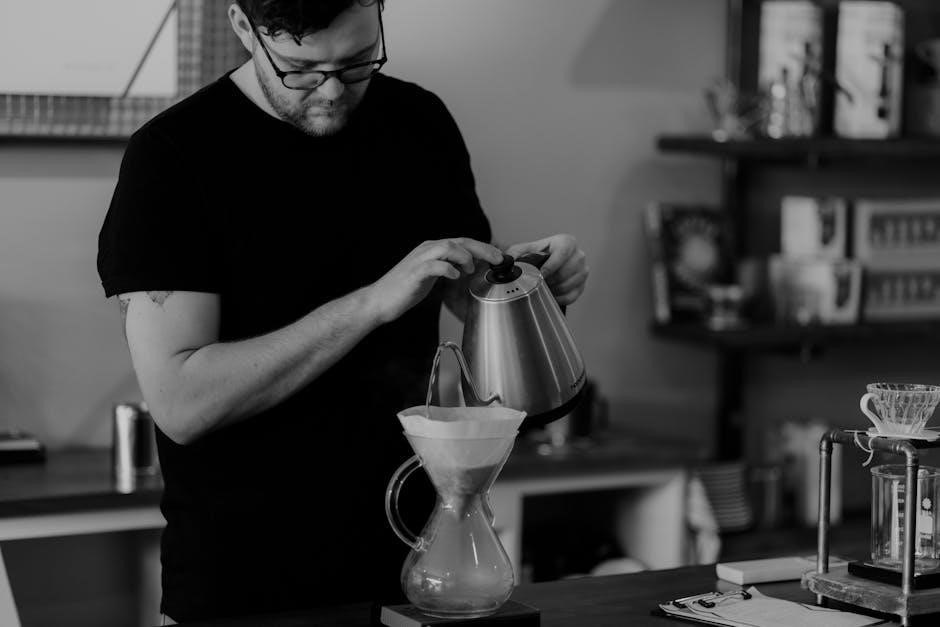
chemex pour over instructions
The Chemex pour-over method offers a clean, balanced extraction with its iconic glass design. This manual brewing process allows for precise control over flavor and strength, ensuring a delightful cup every time.
Overview of the Chemex Brewing Method
The Chemex brewing method is a manual pour-over technique that produces clean, balanced coffee with a distinctive clarity. It involves slowly pouring hot water over ground coffee beans in a specific sequence, using the iconic hourglass-shaped Chemex glass container. The process relies on gravity to extract flavors from the coffee grounds, resulting in a smooth, full-bodied brew. The thick glass construction and paper filters of the Chemex contribute to its unique extraction process, minimizing bitterness and emphasizing nuanced flavors. This method is popular among coffee enthusiasts for its simplicity, control, and ability to consistently deliver high-quality results.
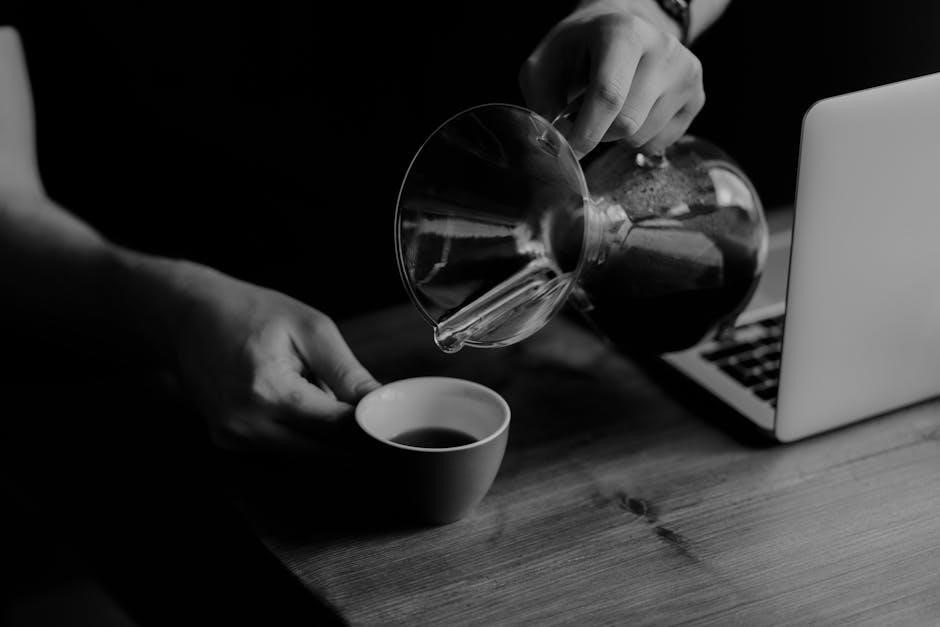
Benefits of Using a Chemex for Pour-Over Coffee
The Chemex pour-over method offers several advantages, making it a favorite among coffee enthusiasts. Its thick glass construction and paper filters ensure a clean, balanced extraction with minimal bitterness. The unique hourglass design allows for even saturation of coffee grounds, promoting uniform flavor extraction. Additionally, the Chemex is easy to clean and maintain, making it a practical choice for daily use. It also produces a high volume of coffee, ideal for serving multiple people. The clarity and purity of the brew are unmatched, highlighting the nuanced flavors of the coffee beans. This method provides a perfect balance of simplicity, control, and exceptional taste.
Materials and Tools Needed
To brew coffee with a Chemex, you’ll need a few essential tools. Here’s a list of what you’ll need to get started.
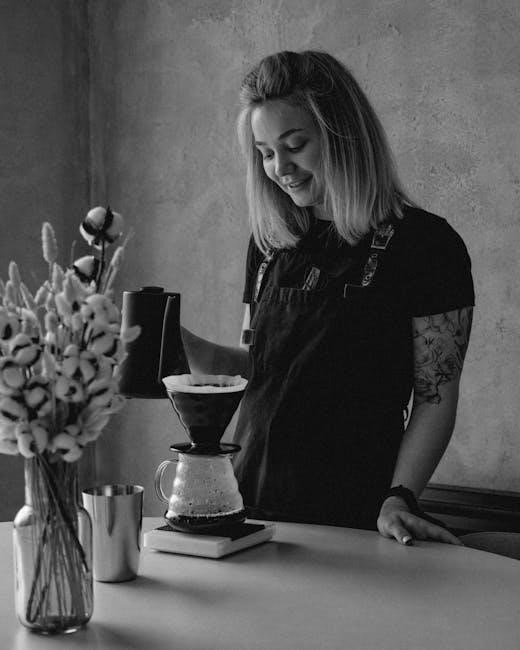
Coffee Beans and Grinders
High-quality coffee beans are essential for a great Chemex brew. Freshly roasted and ground beans ensure optimal flavor and aroma. For best results, use specialty-grade beans roasted within the last week. A burr grinder is recommended over a blade grinder, as it produces a consistent grind size, crucial for even extraction. Medium-coarse grind is ideal for Chemex brewing. Invest in a good grinder to control the grind size precisely. Freshly grinding your beans just before brewing ensures maximum flavor. Additionally, a scale helps measure the perfect coffee-to-water ratio, typically 1:15 to 1:17 for Chemex. Proper equipment and fresh beans lay the foundation for a perfect cup.
Chemex Brewer and Filters
The Chemex Brewer is a glass pour-over coffee maker with a distinctive hourglass shape. It requires specialized paper filters, which are thicker than standard filters, to ensure clean extraction. These filters are designed to remove impurities and oils, resulting in a smooth, balanced cup. The Brewer comes in various sizes, such as 6-cup or 8-cup versions. Always use the correct size of Chemex filter for your Brewer to prevent overflow or under-extraction. Before brewing, rinse the filter with hot water to eliminate any paper taste. Proper use of the Brewer and filters is essential for achieving the desired flavor profile. Regular cleaning of the Brewer ensures optimal performance.
Kettle and Thermometer
A kettle is essential for heating water to the ideal temperature for brewing coffee. A gooseneck kettle is recommended for precise control during the pour-over process. Pair it with a thermometer to monitor water temperature, which should be between 195°F and 205°F for optimal extraction. Some kettles come with built-in thermometers, while others require a separate device. Accurate temperature control ensures the coffee extracts evenly, avoiding under- or over-extraction. Allow the water to cool slightly after boiling to reach the perfect range. Using a thermometer guarantees consistency in your brew and helps achieve the best flavor from your coffee beans.
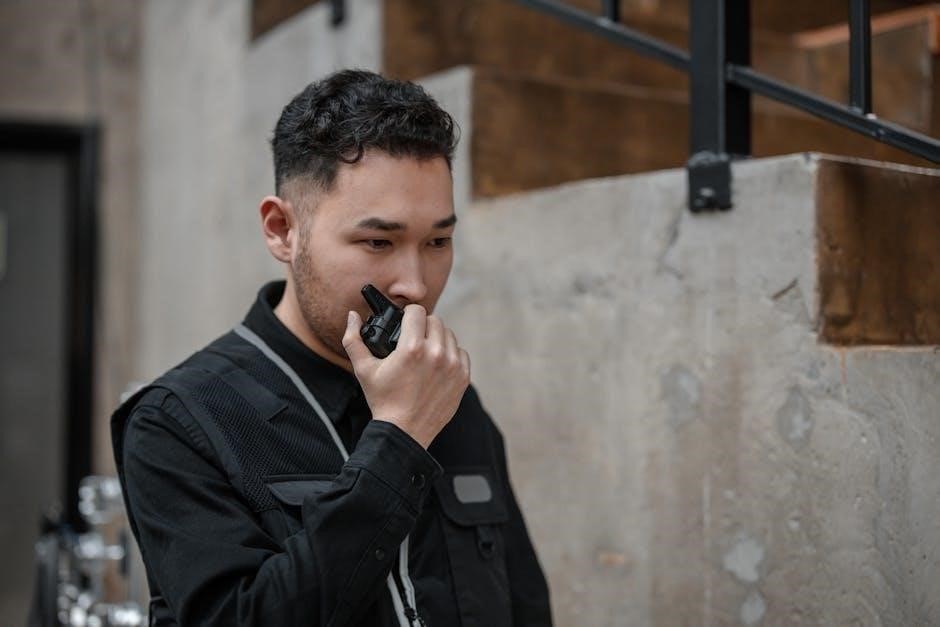
Scale and Timer
A scale is crucial for measuring the precise amount of coffee and water, ensuring a balanced brew. A timer helps monitor the brewing process, essential for achieving optimal extraction. Use the scale to measure coffee according to your preferred ratio, typically 1:15 to 1:17 for Chemex. The timer ensures you bloom the coffee for 30-45 seconds and complete the pour-over within 3-4 minutes. Precision in measurement and time leads to consistent results. Both tools are indispensable for mastering the technique and enjoying a perfectly balanced cup of coffee every time.
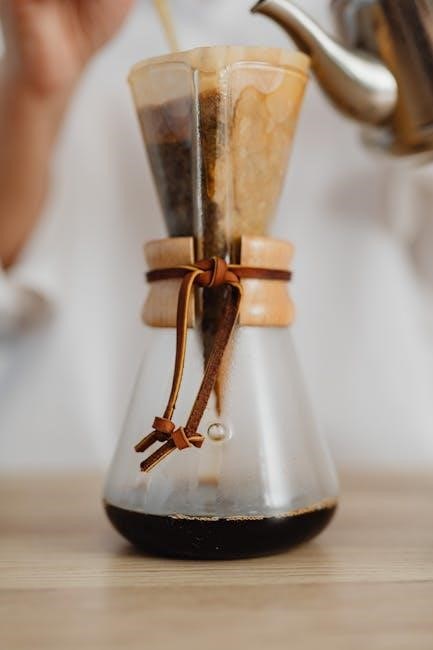
Understanding the Chemex Equipment
The Chemex brewer features a heat-resistant glass container with a distinctive hourglass shape, a handle for easy pouring, and a spout for smooth, drip-free serving.
Components of the Chemex Brewer
The Chemex brewer consists of a heat-resistant, non-porous glass container with an hourglass design, a handle for easy pouring, and a spout for smooth liquid flow. It includes a removable glass lid to retain heat during brewing. The device also features a cone-shaped filter holder that secures the paper filters in place, ensuring even extraction. Additionally, some models come with optional accessories like a glass stir stick. The design is minimalist, durable, and dishwasher-safe, making it both functional and easy to maintain. Each component is carefully crafted to enhance the brewing process and deliver a clean, balanced cup of coffee.
Importance of Chemex Filters
Chemex filters are thick, high-quality paper filters designed specifically for the Chemex brewer. Their unique three-layer design ensures even extraction and prevents coffee grounds from passing into the final brew. The filters are shaped to fit the cone of the Chemex, promoting optimal water flow and saturation of the coffee. They also remove impurities and oils, resulting in a cleaner, smoother cup. Using the correct filter size is crucial, as smaller or improperly fitted filters can lead to under-extraction or uneven brewing. The filters are a key component of the Chemex method, contributing to its signature balanced and flavorful coffee. They are essential for achieving the desired taste and aroma in every brew.
How the Chemex Design Affects Extraction
The Chemex’s design significantly influences the extraction process, ensuring a balanced and flavorful brew. Its hourglass shape promotes even water flow through the coffee grounds, preventing channeling and uneven extraction. The narrow neck slows down drainage, allowing for a longer extraction time. The thick, heat-resistant glass maintains a stable temperature, crucial for proper extraction. The specialized paper filters, thicker than average, absorb impurities and oils, leading to a cleaner taste. The restricted flow due to the filters and neck design extends the extraction time, preventing under-extraction. Overall, the Chemex’s unique design elements work together to control water flow, maintain temperature, and ensure even saturation, resulting in a refined and balanced cup of coffee.
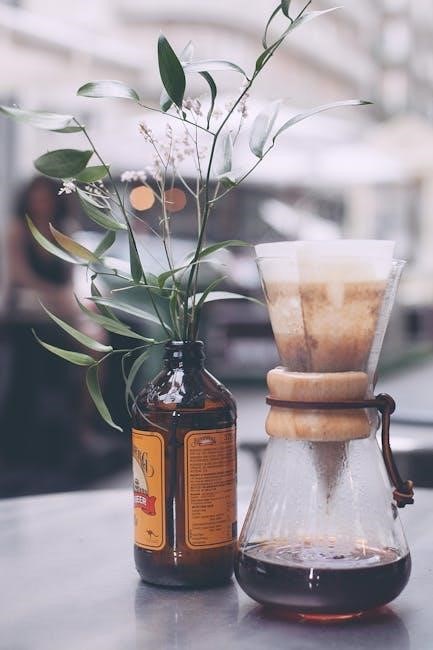
Preparation Steps for Brewing
Start by gathering all materials, rinsing the filter, and positioning the Chemex. Ensure the scale and timer are ready for precise measurements and timing.
Preheating the Chemex and Filter
Preheating the Chemex and its filter is essential to ensure even extraction and prevent temperature shock. Start by rinsing the filter with hot water, then discard the water. This step removes any paper taste and warms the glass. Next, pour a small amount of hot water into the Chemex to warm it, swirling it around to coat the interior. Discard the water and ensure the Chemex is dry before adding coffee. This process ensures the brewing temperature remains consistent, which is crucial for optimal flavor extraction. Always use fresh, hot water for preheating to maintain the best possible conditions for your pour-over coffee.
Measuring Coffee and Water Ratio
Measuring the coffee-to-water ratio is critical for a balanced brew. The standard ratio for Chemex is 1:16 (one gram of coffee for every 16 grams of water). For a typical 6-cup Chemex, use 42 grams of coffee and 672 grams of water. Adjust the ratio to suit your taste preferences—stronger brews may use 1:15, while lighter ones might use 1:17. Use a digital scale for precision. Pour water in a circular motion to evenly saturate the grounds. Maintaining this ratio ensures optimal extraction and flavor. Experiment with small adjustments to find your perfect balance, as the ratio significantly impacts the final taste of your coffee.
Grinding Coffee for Chemex
Grinding your coffee beans just before brewing ensures maximum flavor and aroma. For Chemex, a medium-coarse grind is ideal, as it allows for even extraction during the pour-over process. Use a burr grinder, as it produces a consistent grind without generating heat, which can damage the beans. Blade grinders are less precise and can lead to uneven extraction. Aim for a grind size similar to kosher salt or coarse sand. If the grind is too fine, it may clog the filter, leading to under-extraction. If too coarse, the coffee may taste weak. Experiment to find the perfect grind for your preferred flavor profile.
Blooming the Coffee
Blooming the coffee is a critical step in the Chemex process that ensures even extraction. Start by pouring a small amount of hot water (about 1-2 tablespoons) over the ground coffee. Allow it to “bloom” for 30-45 seconds. This step releases trapped gases in the coffee, enhancing flavor and aroma. Use water at 200°F for optimal blooming. During this time, you’ll notice the coffee expand slightly and release a fragrant aroma. After blooming, proceed with the rest of the pour-over process. Adjusting the bloom time can help achieve the perfect balance of extraction and flavor in your final cup of coffee.
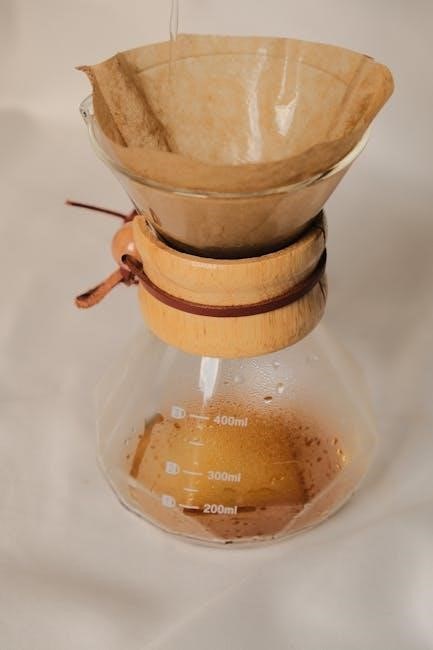
The Pouring Process
The pouring process involves carefully adding water in phases, starting with the bloom, followed by the first pour, and subsequent pours to evenly saturate grounds.
Initial Pour and Bloom Phase
The initial pour begins by adding a small amount of hot water (about 40-50 grams) to saturate all coffee grounds evenly. This step is called the “bloom” phase, allowing the coffee to release trapped gases, particularly carbon dioxide, which enhances flavor and aroma. Stir gently to ensure all grounds are covered. Let it bloom for 30-45 seconds. This step is crucial for achieving balanced extraction and preventing channeling. After blooming, the coffee will expand slightly, indicating the release of gases. This phase sets the foundation for the rest of the brewing process, ensuring even extraction and optimal flavor development.
First Pour After Bloom
After the bloom phase, the first pour involves adding approximately 100-150 grams of water in a circular motion, starting from the center and moving outward. This ensures even saturation of the coffee grounds. Pour slowly to avoid disturbing the coffee bed or washing away the bloom. The water should flow gently, creating a ripple effect. The total water added after this pour should bring the cumulative amount to around 240 grams. This step begins the extraction process, allowing the coffee to drain gradually into the lower chamber. The pour should take about 45 seconds, maintaining a steady flow to promote even extraction and prevent channeling.
Subsequent Pours and Agitation
After the first pour, two more pours are typically performed, each adding 100-150 grams of water. Pour in a circular motion, starting from the center and moving outward to ensure even saturation. Avoid pouring directly onto the filter to prevent channeling. After the final pour, gently agitation the mixture by swirling the Chemex for about 10 seconds to promote even extraction. This step helps release any trapped gases and ensures all grounds are saturated. The total brew time should be around 4 minutes, with the last pour occurring at the 3-minute mark. Agitation enhances flavor balance and consistency in the final cup.
Final Pour and Drainage
The final pour is the last step before drainage. After the third pour, allow the coffee to drain completely. This ensures all liquids pass through the filter evenly. Once the dripping stops, discard the filter and grounds. The total brew time should be around 4 minutes. Rinse the Chemex with hot water to remove any residual coffee oils. This step prevents bitterness and ensures a clean flavor in your next brew. Proper drainage is key to avoiding over-extraction. Allow the coffee to settle before serving. Pour slowly to prevent stirring up sediments. Your Chemex is now ready to serve a perfectly balanced cup of coffee.

Optimizing Your Brew
To optimize your Chemex brew, monitor extraction time, flavor balance, and pouring technique. Adjust as needed to ensure consistency and suit your taste preferences.
Adjusting Coffee-to-Water Ratio
Adjusting the coffee-to-water ratio is vital for achieving your desired flavor in a Chemex brew. Start with the standard 1:16 ratio, using one gram of coffee for every 16 grams of water. For a stronger cup, increase the coffee proportion to 1:15, and for a lighter brew, try 1:17. Use a digital scale for precise measurements. Be mindful of the Chemex filter’s thickness, as it can influence water flow. After blooming, pour the main water volume accordingly. Monitor total brew time and adjust the ratio based on taste preferences. Experiment with small changes to find your perfect balance, ensuring consistency and flavor satisfaction.
Grind Size Adjustments

Grind size plays a significant role in achieving optimal extraction with a Chemex. Aim for a medium-coarse grind, slightly coarser than kosher salt, to allow for even water flow through the thick filter. If the coffee brews too quickly, the grind may be too coarse, leading to under-extraction. Conversely, a grind that’s too fine can cause over-extraction and a bitter taste. Adjust the grind based on your brew time: a coarser grind for faster brews and a finer grind for slower ones. For best results, use a burr grinder, as blade grinders can create inconsistent particles. Experiment with small adjustments to find the perfect balance for your desired flavor profile.
Water Temperature and Its Impact
Water temperature is crucial for achieving the perfect Chemex brew. Ideal brewing temperature ranges between 195°F and 205°F, just below boiling point. Water that’s too hot can burn the coffee, leading to bitter flavors, while water that’s too cool may result in under-extracted, sour notes. Use a thermometer to monitor the temperature accurately. For optimal extraction, heat water to around 200°F before pouring. Adjust the temperature slightly based on the coffee beans’ origin and roast level, as darker roasts may benefit from slightly cooler water. Consistent temperature ensures balanced extraction and a flavorful cup every time.
Stirring and Agitation Techniques
Stirring and agitation play a vital role in ensuring even extraction during the Chemex brewing process. After the bloom phase, gently stir the coffee grounds to saturate them evenly, preventing channeling and under-extraction. Use a spoon to carefully agitate the mixture, making sure all grounds are in contact with water. Be cautious not to over-agitate, as this can lead to over-extraction and a bitter taste. Stirring once or twice during the pouring process is typically sufficient. This technique helps distribute heat evenly and ensures a balanced flavor in your final brew. Consistent agitation leads to a more uniform extraction and a satisfying cup of coffee.
Timing and Extraction Control
Timing is crucial for achieving optimal extraction in Chemex brewing. The total brew time should be around 4 minutes, including the bloom phase. Proper timing ensures the coffee is neither under-extracted nor over-extracted. Start by blooming the coffee for 30-45 seconds to release gases. Then, pour the remaining water in a controlled manner, maintaining a steady flow. Use a timer to monitor the process and adjust the pour speed as needed. Even saturation of all grounds is key for balanced extraction. Aim for the entire process to finish within 4 minutes to ensure a smooth, flavorful cup. Consistent timing leads to consistent results.
Tips for a Perfect Cup
Consistency is key to mastering the Chemex. Experiment with ratios, grind sizes, and techniques to refine your brew. Patience and attention to detail yield exceptional results.
Using Fresh and High-Quality Coffee
For an exceptional Chemex brew, prioritize fresh, high-quality coffee beans. Opt for beans roasted within the last 7–14 days to ensure optimal flavor and aroma. Fresh beans ensure a vibrant bloom and balanced extraction. Buy from reputable roasters or local coffee shops to guarantee quality. Avoid pre-ground coffee, as it loses freshness quickly. Invest in a good grinder to prepare whole beans just before brewing, preserving volatile compounds that enhance flavor. Experiment with single-origin beans to experience unique regional profiles. Fresh coffee is the foundation of a perfect cup, so never compromise on quality or freshness for the best results.
Storing Coffee for Optimal Flavor
To preserve the flavor and aroma of your coffee, proper storage is essential. Use an airtight container made of glass or ceramic, avoiding metal or plastic, which can impart odors. Store the container in a cool, dark place, such as a pantry, away from direct sunlight and heat sources. Freezing coffee beans is also effective for longer storage, but ensure they are portioned to avoid repeated thawing. Refrigeration is not recommended due to moisture and potential odor absorption. For the best results, use freshly roasted beans within two weeks and grind them just before brewing. Proper storage ensures your coffee remains fresh and flavorful for an exceptional Chemex brew.
Cleaning and Maintaining the Chemex
Cleaning your Chemex is crucial for maintaining its performance and ensuring a clean-tasting brew. After each use, rinse the glass container thoroughly with warm water to remove any residual coffee oils. Avoid using abrasive cleaners or scourers, as they can scratch the glass. For deeper cleaning, mix equal parts water and white vinegar, and let it soak inside the Chemex for about 30 minutes. Rinse thoroughly to eliminate any vinegar taste. The wooden handle can be wiped with a damp cloth. Regular cleaning prevents mineral buildup and old coffee residue from affecting the flavor of your brew. A well-maintained Chemex will last for years and continue to deliver exceptional results;
Experimenting with Roast Levels
Experimenting with different roast levels can elevate your Chemex brewing experience. Lighter roasts offer brighter acidity and nuanced floral or citrus notes, while medium roasts provide a balanced, smooth flavor with hints of chocolate. Darker roasts deliver bold, rich profiles with deep sweetness and caramel undertones. The Chemex’s glass design allows you to observe the coffee’s clarity and color, which vary with roast levels. Adjusting your roast preference can tailor the brew to your taste preferences. Start with lighter roasts for a vibrant cup or opt for darker roasts for a more robust experience. Each roast level brings unique characteristics, making experimentation a fun way to explore coffee’s diversity.
Troubleshooting Common Issues
Identify and resolve common brewing issues like under-extraction, over-extraction, or channeling by adjusting grind size, water temperature, and pouring techniques for a balanced cup.
Under-Extraction and Sour Coffee
Under-extraction occurs when coffee grounds don’t release enough flavor, often due to insufficient coffee, fine grind size, or low water temperature. This can result in a sour taste. To fix, ensure a balanced coffee-to-water ratio, adjust grind to medium-coarse, and maintain water at 200°F. Proper blooming and even pouring help prevent channeling. Adjusting these factors can lead to a balanced extraction and a smoother cup of coffee.
Over-Extraction and Bitter Coffee
Over-extraction occurs when too much flavor is pulled from the coffee, resulting in a bitter taste. This can happen if the coffee-to-water ratio is too high, the grind size is too fine, or the water temperature is excessively hot. Additionally, steeping the coffee for too long can exacerbate bitterness. To address this, reduce the coffee amount, use a coarser grind, and lower the water temperature slightly. Ensure even water distribution during pours to avoid channeling, which can lead to uneven extraction. Adjusting these factors will help prevent bitterness and achieve a smoother, balanced brew in your Chemex.
Channeling and Uneven Extraction
Channeling occurs when water flows through the coffee bed unevenly, creating paths that bypass some grounds. This leads to under-extracted areas and over-extracted areas, resulting in an imbalanced flavor. Causes include improper coffee distribution, an uneven filter placement, or pouring water too quickly. To prevent channeling, ensure the coffee grounds are evenly distributed and the filter is properly seated. Pour water in a steady, circular motion to saturate all grounds uniformly. Avoid pouring too much water at once, as this can disrupt the bed. Use a consistent grind size and allow the bloom to develop fully before subsequent pours to promote even extraction.
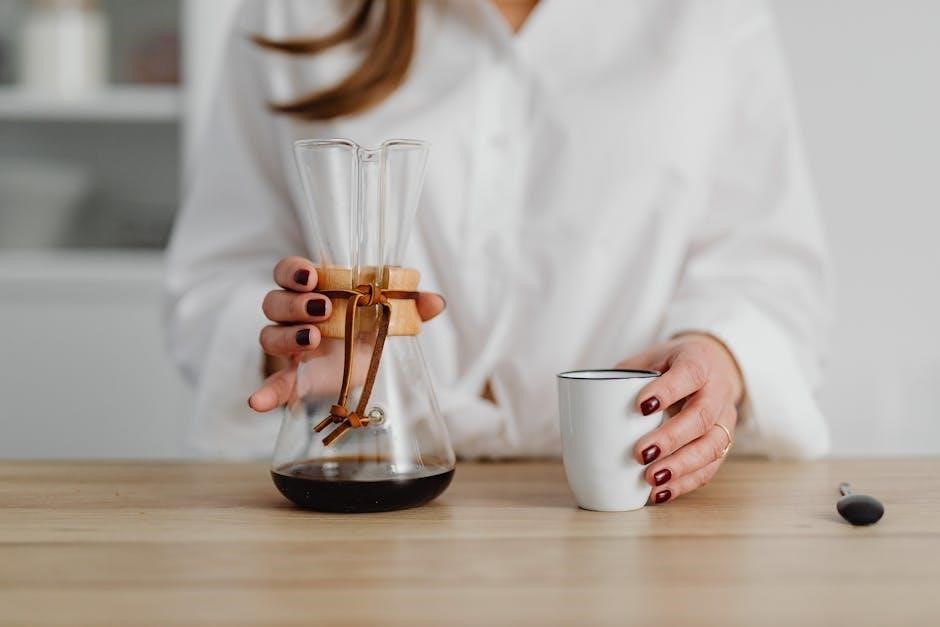
Adjusting for Different Coffee Beans
Different coffee beans require tailored brewing approaches due to variations in processing, roast levels, and origin. Lighter roasts often benefit from a slightly coarser grind to avoid over-extraction, while darker roasts may need a finer grind for balanced flavor. The coffee-to-water ratio can also be adjusted; denser beans might require a higher ratio to prevent bitterness. Blooming time may vary depending on the bean’s freshness and CO2 levels. Experiment with grind size, bloom duration, and pour speed to optimize extraction. Taste the coffee after brewing to determine if adjustments are needed, ensuring each bean’s unique characteristics shine through. Keep notes to refine your approach for specific beans.
Mastering the Chemex pour-over method yields clean, balanced coffee. Experiment with ratios, grind sizes, and techniques to refine your brew. Consistency comes with practice, so keep perfecting your craft. Enjoy the perfect cup every time!
Final Tips for Consistency
Consistency in Chemex brewing comes from attention to detail. Always use freshly roasted beans and store them in an airtight container. Measure coffee and water precisely with a scale. Heat water to 195–205°F for optimal extraction. Preheat the Chemex and filter to ensure even temperature. Pour at a steady, controlled rate to avoid channeling. Clean the Chemex thoroughly after each use to prevent residue buildup. Experiment with grind sizes and bloom times to find your ideal balance. Keep track of your brewing parameters to replicate results. Practice makes perfect—refine your technique over time for a consistently delicious cup every time.
Enjoying Your Perfect Chemex Brew
Once your Chemex brew is ready, take a moment to appreciate the aroma and clarity. Pour the coffee into your favorite mug or cup. For a richer experience, add milk, sugar, or creamer to taste. Pair it with pastries, toast, or fruit for a delightful accompaniment. Experiment with different roast levels to discover your preferred flavor profile. Share your brew with friends or savor it alone—each sip is a reward for your careful preparation. Store leftover coffee in an insulated container to preserve warmth and flavor. Embrace the ritual of enjoying your craft-brewed coffee, knowing the effort you put into creating it.